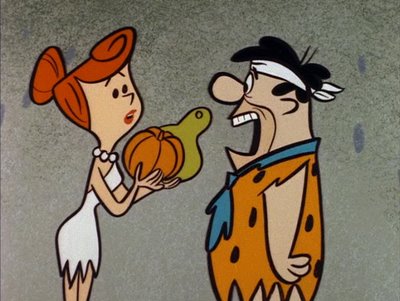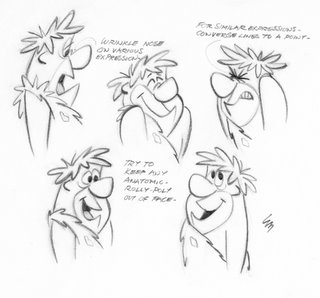Here are 2 of my favorite stereotyped typical primitive every day white men. Loud, obnoxious, arrogant and stupid. We all have pointy noses that stick way out from our faces. We have no lips either. Only our women have any brains. But most offensive to me personally is the idea that we have triangles for ears.  Animation is even more mired in generalization these days, that it discourages variety in character designs of any species. Many cartoons today think it's a sign of quality to have every character look exactly the same as each other - especially in prime time. Even the dog will have the same face as its master, except with a dog nose pasted on. Animation has always had to fight against its own tendency to generalize, but it's worse than ever today.
Animation is even more mired in generalization these days, that it discourages variety in character designs of any species. Many cartoons today think it's a sign of quality to have every character look exactly the same as each other - especially in prime time. Even the dog will have the same face as its master, except with a dog nose pasted on. Animation has always had to fight against its own tendency to generalize, but it's worse than ever today.
If your show is in a hip "pointy style", then every character is crawling with corners - and no individual face. Animation producers and executives and even creators just love to come up with tons of rules to stifle the imaginations of the few creative cartoonists we actually have in the industry.
This was not always quite so severe.


There was a time when individual characters changed all the time from cartoon to cartoon - or even within the same cartoon. And I love this variety.
http://www.animationarchive.org/2008/09/biography-john-k-on-flintstones.html
I have always loved cartoons, where you could tell the difference between animators by how they drew (and moved) the same characters.

Not only am I for creating distinct specific characters, I take it even further than that. I want each instance of each character to be diverse in the specifics, yet maintain his own general traits.

The biggest misunderstanding of a classic animation tool is the slavery to the model sheets that top animation brass foists on us today.
Model sheets used to be drawn to help animators get a round about visual description of the characters. It was still expected of the animators to come up with their own specific poses and expressions. Each animator would also draw the character's details in his own style. He couldn't help it. It's natural for actual creative people to put their own stamp on a character or even a scene. We are doing it, even when we try not to.
 So I'm amazed that we have arguments about how we need to have less stereotypes in cartoons, when every studio you work at beats generalization into you until it becomes impossible for you to do anything unique that might break out of the whole generic field.
So I'm amazed that we have arguments about how we need to have less stereotypes in cartoons, when every studio you work at beats generalization into you until it becomes impossible for you to do anything unique that might break out of the whole generic field.
Yes please, let's make individual characters - and then on top of that - individual instances of each character for each emotion and for each artist.
Even the Flintstones, which were wildly erratic and "off-model" in the beginning are very generalized, toned-down versions of real living characters who had a lot more specific physical traits and personalities.
I used to have heated arguments with Ed Benedict about whether or not an animator should have some leeway to stray from the models at all. As unique a designer as he was, even he had been trained into believing that every animator had to draw the same way according to the tyrannical model sheets. But it's practically impossible for real creative people to do that.
http://johnkstuff.blogspot.com/2007/05/ralph-and-norton-hide-outside-window.html
 Animation is even more mired in generalization these days, that it discourages variety in character designs of any species. Many cartoons today think it's a sign of quality to have every character look exactly the same as each other - especially in prime time. Even the dog will have the same face as its master, except with a dog nose pasted on. Animation has always had to fight against its own tendency to generalize, but it's worse than ever today.
Animation is even more mired in generalization these days, that it discourages variety in character designs of any species. Many cartoons today think it's a sign of quality to have every character look exactly the same as each other - especially in prime time. Even the dog will have the same face as its master, except with a dog nose pasted on. Animation has always had to fight against its own tendency to generalize, but it's worse than ever today.If your show is in a hip "pointy style", then every character is crawling with corners - and no individual face. Animation producers and executives and even creators just love to come up with tons of rules to stifle the imaginations of the few creative cartoonists we actually have in the industry.
This was not always quite so severe.


There was a time when individual characters changed all the time from cartoon to cartoon - or even within the same cartoon. And I love this variety.
http://www.animationarchive.org/2008/09/biography-john-k-on-flintstones.html
I have always loved cartoons, where you could tell the difference between animators by how they drew (and moved) the same characters.

Not only am I for creating distinct specific characters, I take it even further than that. I want each instance of each character to be diverse in the specifics, yet maintain his own general traits.


The biggest misunderstanding of a classic animation tool is the slavery to the model sheets that top animation brass foists on us today.
Model sheets used to be drawn to help animators get a round about visual description of the characters. It was still expected of the animators to come up with their own specific poses and expressions. Each animator would also draw the character's details in his own style. He couldn't help it. It's natural for actual creative people to put their own stamp on a character or even a scene. We are doing it, even when we try not to.
 So I'm amazed that we have arguments about how we need to have less stereotypes in cartoons, when every studio you work at beats generalization into you until it becomes impossible for you to do anything unique that might break out of the whole generic field.
So I'm amazed that we have arguments about how we need to have less stereotypes in cartoons, when every studio you work at beats generalization into you until it becomes impossible for you to do anything unique that might break out of the whole generic field.
Yes please, let's make individual characters - and then on top of that - individual instances of each character for each emotion and for each artist.
Even the Flintstones, which were wildly erratic and "off-model" in the beginning are very generalized, toned-down versions of real living characters who had a lot more specific physical traits and personalities.

I used to have heated arguments with Ed Benedict about whether or not an animator should have some leeway to stray from the models at all. As unique a designer as he was, even he had been trained into believing that every animator had to draw the same way according to the tyrannical model sheets. But it's practically impossible for real creative people to do that.
http://johnkstuff.blogspot.com/2007/05/ralph-and-norton-hide-outside-window.html

